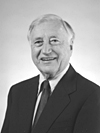-
(b.) -1916 March 07(d.)2003 April 26
Bio/Description
A Professor emeritus of computer science at Stanford University, he taught the first programming course at Stanford and helped found the Computer Science Department. He also served as first Director of the Stanford Computation Center, which later evolved to become what is now Information Technology Systems and Services (ITSS), the department that provides computing infrastructure and services. Born in Winnipeg, Manitoba, Ontario, Canada, his father was a professor of Civil Engineering at the University of Manitoba and his mother, a homemaker. In 1937, he received his Bachelor's degree, with honors, in Mathematics and Physics from the University of Manitoba. In 1941, he earned a Doctoral degree in Mathematics from Brown University. It was there that he met his future wife, Sally. He taught Math at Yale from 1941 to 1942 and at Stanford from 1942 to 1944. From 1944 to 1946, he studied airflow over airplane wings for the precursor to NASA in the Ames Aeronautical Laboratory at Moffett Field. He returned to Stanford as an Assistant Professor of Mathematics In 1946, becoming an Associate Professor in 1949 and Full Professor in 1956. In 1952, the university decided to acquire its first computer, an IBM Card Programmed Calculator (CPC), and sought a faculty mathematician to lead the Stanford Computation Center, which was born with the computer's arrival in 1953. He assumed the responsibility as his chief non-teaching activity, and served as the center's Director from 1953 to 1961. Over time, the center evolved from serving a few pioneering researchers to serving the entire university. When he became the center's Director, his work veered from pure mathematics to computer-oriented research, which focused on numerical analysis, especially development of problem-solving algorithms. During this time - the infancy of computers - some viewed the machines more as glorified calculators than as launching points for an academic discipline. In 1955, he taught Stanford's first programming course, Math 139: Theory and Operation of Computing Machines. Enrollment mushroomed from 25 students in 1955 to 150 in 1959. In 1956, he started teaching Math 239: Computer Laboratory, which students took to complete projects required for a new Math master's program in Scientific Computation. That year the university acquired its second computer, an IBM 650, which was three to five times faster than its predecessor. A press release quoted him as saying the machine "will make possible the solution of problems we couldn't even attempt before." In 1957, he helped recruit George Forsythe to the Math Department to help with the teaching workload created by the increased enrollment in computer courses. The two had been friends since graduate school. In 1961, Forsythe became head of the Computation Center and the newly formed Computer Science division of the Math Department, which later became home to academicians in the emerging field of Computer Science, such as artificial intelligence pioneer John McCarthy. In 1965, under Forsythe's leadership, he and other faculty in the computer science division moved to the new Computer Science Department which was one of the world's first. He and Forsythe were co-founders of the undergraduate program in Mathematical and Computation Sciences. He served as acting Chair of the Computer Science Department from 1966 to 1967 when Forsythe was on sabbatical, and again from 1972 to 1973 after Forsythe died of cancer at age 55. "When computers first came to the Stanford campus, Herriot was in charge," recalled Edward Feigenbaum, the Kumagai Professor Emeritus in the School of Engineering. "Long before Forsythe and the rest of us, it was Jack Herriot. From a historical perspective, he represented the continuity between the Forsythe era and what came later." He authored or co-authored about 40 publications and served as editor of the Algorithms Department of Communications of the Association for Computing Machinery. He retired in 1982 and subsequently spent his time skiing in the Sierras, Rockies and Europe for six weeks a year into his 80s, ushering at San Francisco Opera performances and traveling. He and his wife celebrated their 60th wedding anniversary in the fall of 2001.
-
Date of Birth:
1916 March 07 -
Date of Death:
2003 April 26 -
Noted For:
Teacher of the first programming course at Stanford University and helped found its Computer Science Department -
Category of Achievement:
-
More Info:


